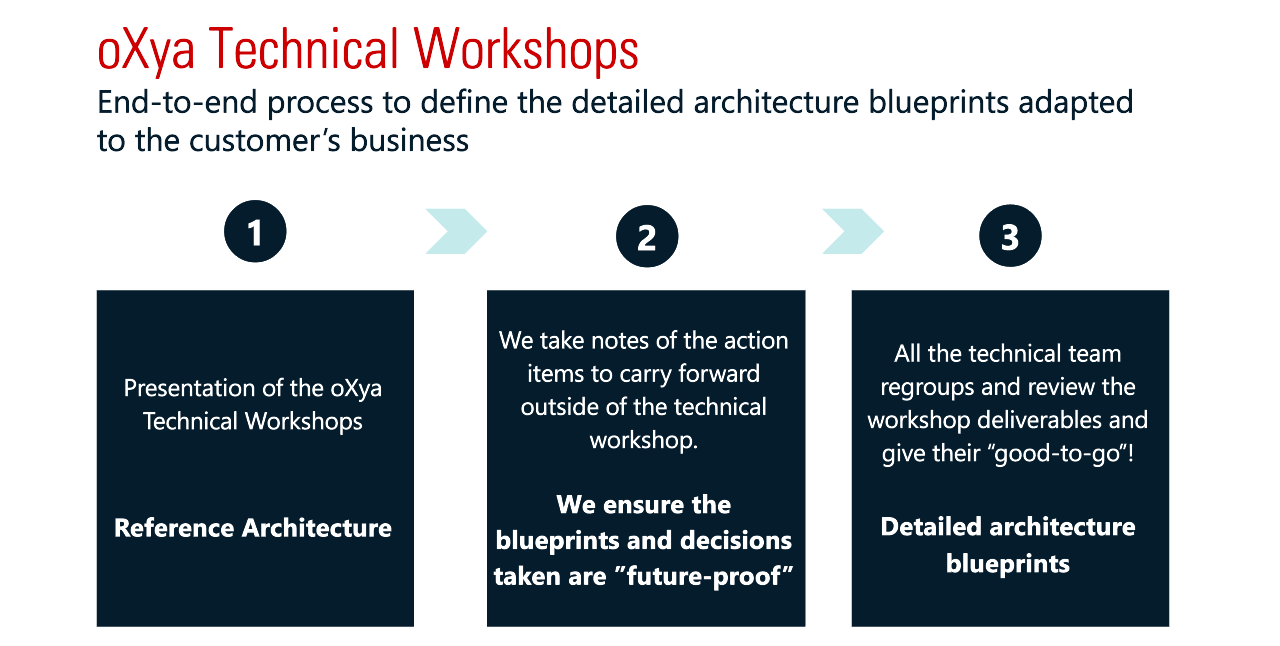5 Best Practices for A Successful SAP Migration Project
SAP application migration projects – just like any other types of ERP – are among the most complex IT projects to undertake. Needless to say, rigor is essential. In this context, a methodical and proactive project management ensures the most fruitful results.
In addition to following the standards and best practices of the PMI (Project Management Institute), oXya distinguishes itself from its competitors in several ways, notably by assigning a technical project manager and adopting a proven project methodology adapted to the specificities of the critical applications of our oXya workshops.
Learn more about what sets us apart by discovering our 5 best practices in project management to migrate your mission critical workloads to the cloud.
- Defining a project at the heart of a strategic vision;
- Laying the right foundations to kick-start your project: the oXya Technical Workshops;
- Setting up the right KPIs to control your project;
- Establishing a precise communication plan adapted to the project;
- Identifying risks to make your project run more smoothly.

Best Practice No. 1 – Defining A Project at The Heart of a Strategic Vision
Understanding and precisely defining the organization’s strategic objectives is a fundamental step before starting any SAP migration project. From the pre-sales phase onwards, we work with our network of partners to offer our customers a complete cloud solution that is as tailored as possible.
A simple example! Migrating mission-critical applications to the public cloud can also means bringing your data closer to the native artificial intelligence and machine learning services offered by all hyperscalers. Other reasons for move-to-cloud may come from hardware reaching the end of its life cycle, or from reducing the Total Cost of Ownership (TCO).
You can check out our latest blog on 5 trends that should matter to every CIOs.
Best Practice No. 2 – Laying the Right Foundations to Kick-Start Your Project: the oXya Technical Workshops
Successful, smooth-running projects are built on solid foundations. That’s why our oXya Technical Workshops help you get off on the right foot.
In the first few weeks of a project, we present a series of workshops to the customer, starting with a reference architecture and adapting it to the customer’s specific needs.
During these technical workshops, we discuss a range of topics together, including:
- Setting up the welcome area on the new cloud;
- Blueprints and T-shirt sizes for virtual machines;
- Technical architecture of critical high-availability applications;
- Definition of backup site requirements;
- Migration roadmap;
- Cybersecurity and compliance considerations;
- Communication plan to be followed during the project.
It also involves identifying the right people for each workshop, both from our team and yours. We share our oXya experience on these large-scale projects, and prepare each meeting meticulously to ensure that it runs smoothly and efficiently.
We also address day #1 support topics such as performance management with the Xperion service, vulnerability risk assessment with Cyberwatch, automated SAP System Copy with Libelle …

Best Practice No. 3 – Setting Up the Right Key Performance Indicators to Control Your Project
More often than not, an SAP migration project correspond to a release date from a hosting provider. Controlling the timeline is therefore of crucial importance. Similarly, switching to the production environment sometimes requires a window of unavailability that needs to be planned well in advance. Any delays having a domino effect on the project can therefore have costly consequences.
We therefore offer close monitoring and a project management methodology based on Key Performance Indicators (KPIs), so as to leave no blind spots. For example:
- Tracking of the project’s high-level schedule (the timeline);
- Following up on tension indicators on the project’s critical path (current vs. planned);
- Weekly analysis of action items, prioritized by health;
- Progress of each deliverable, etc.
Best Practice No. 4 – Establishing A Precise Communication Plan Adapted to the Project
The number of project stakeholders involved in an SAP migration project is usually significant. SAP applications are at the heart of our customers’ IT architecture, and directly or indirectly affect all their business units. The communication plan is therefore essential to maintain a clear vision of the project’s progress, while providing the right level of information to every resource on the project, as well as to the executive sponsors and our business partners.
oXya therefore organizes its project around various types of meetings (virtual or in person), to take the pulse of the project. In order to make the most efficient use of everyone’s time, we always rely on good upstream preparation.
This is where the presence of a technical project manager comes into its own, not only to bridge the gap between information levels, but also to enable each member to express themselves, understand each other and work together.
Best Practice No. 5 – Identifying Risks to Make Your Project Run More Smoothly
Every project bears its share of unknowns. You need to leave room in the project plan for the flexibility to build the aircraft in flight. A proper risk management approach is the best way to prepare for this.
As we do, for example, during an SAP upgrade, the risk register enables the various risks to be identified, monitored and an action plan drawn up, right from the start of the project.
By adopting these 5 best practices, oXya succeeds in delivering an optimal customer experience. Moreover, our efficient management enables us to complete migrations in record time, with excellent delivery success. Thanks to these actions, our teams have even managed to deliver migration projects ahead of schedule!





